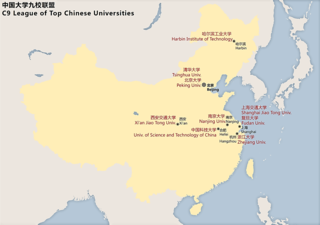
The Harbin Institute of Technology (HIT) is a public science and engineering university in Nan'gang, Harbin, Heilongjiang, China. It is now affiliated with the Ministry of Industry and Information Technology. The university is part of Project 211, Project 985, and the Double First-Class Construction.

The Beijing Institute of Technology (BIT) is a public university in Haidian, Beijing, China. It is affiliated with the Ministry of Industry and Information Technology. The university is part of Project 211, Project 985, and the Double First-Class Construction.

The Renmin University of China (RUC) is a public university in Haidian, Beijing, China. The university is affiliated with the Ministry of Education, and co-funded by the Ministry of Education and the Beijing Municipal People's Government. The university is part of Project 211, Project 985, and the Double First-Class Construction.

Beihang University is a public university in Haidian, Beijing, China. It is affiliated with the Ministry of Industry and Information Technology. The university is part of Project 211, Project 985, and the Double First-Class Construction.

Beijing Foreign Studies University is a public university in Haidian, Beijing, China. It is affiliated with the Ministry of Education. The university is part of Project 211 and the Double First-Class Construction.

The University of Shanghai for Science and Technology is a municipal public university in Yangpu, Shanghai, China. The university is affiliated with the City of Shanghai and funded by the Shanghai Municipal People's Government.

The Central University of Finance and Economics (CUFE) is a public finance and economics university located in Beijing, China. Affiliated with the Ministry of Education of China, the university is co-sponsored by the Ministry of Education, the Ministry of Finance, and the Beijing Municipal People's Government. The university is part of the Double First-Class Construction and Project 211.

Northwestern Polytechnical University is a public science and engineering university in Xi'an, Shaanxi, China. It is affiliated with the Ministry of Industry and Information Technology. The university is part of Project 211, Project 985, and the Double First-Class Construction.
National Key Universities previously referred to universities recognized as prestigious and which received a high level of support from the central government of the People's Republic of China. The term is no longer in official use by 1990s. The term "zhòngdiǎn" 重点, translated here as "key," in this phrase can also be translated as "major," "priority," or "focal." The term "National Key Universities" then became defunct, and these schools are now normally referred to as "Double First Class Universities“, based on the China state Double First-Class Construction. However, it remains part of the vernacular, as evidenced by some Chinese media articles which still refer to "National Key Universities".
Higher education in China is the largest in the world. By the end of 2021, there were over 3,000 colleges and universities, with over 44.3 million students enrolled in mainland China and 240 million Chinese citizens having received high education. The system includes Bachelors, Masters and Doctoral degrees, as well as non-degree programs, and is also open to foreign students.
Wuyi University is a public university based in Jiangmen, Guangdong, China.
Wu Shulian is an individual who created and published by himself the rankings for universities in China. Wu Shulian's ranking has caused significant controversy due to his excessive business operations behind the rankings and for-profit indicator system design of the rankings. The publication of the rankings has been criticized by many Chinese media, including Xinhua News Agency, People's Daily, and Guangming Daily. The Ministry of Education of China strongly opposed the university rankings as it was based on the payment of "fees."

The C9 League (九校联盟) is an inter-university seminar composed of nine public universities in China. It was established on May 4, 1998, at the 100th anniversary of Peking University.

Nanjing University (NJU) is a public university in Nanjing, Jiangsu, China. It is affiliated and sponsored by the Ministry of Education. The university is part of Project 211, Project 985, and the Double First-Class Construction.
Founded on February 25, 2010, the China (Wuxi) University Tech Park of Sensing Network is the first professional high-tech park focusing on research on sensing network in China. It is located in the Taihu International Tech-Park in Wuxi, Jiangsu province and is the only national-level university technology park themed on sensing network.
Zhou Tongqing, also known as Tung-Ching Chow, was a Chinese optical physicist. After earning his Ph.D. from Princeton University, he taught at Peking University, National Central University, Shanghai Jiao Tong University, and Fudan University. He led the development of China's first X-ray tube in 1953 and was elected a founding member of the Chinese Academy of Sciences in 1955. His research was disrupted when he was subject to severe persecution during the Anti-Rightist Campaign and the Cultural Revolution. Although later politically rehabilitated, he was plagued by poor health for the rest of his life.
In China, the 1952 reorganization of colleges and departments in higher education institutions (高等学校院系调整) was a national policy under the Chinese Communist Party (CCP), which came into power in 1949, to adopt Soviet-styled higher education. This policy focused more on engineering education and technical training while removing American influences among Chinese scholars. While eliminating private education, especially missionary higher education, the policy led to the state control over the higher education sector and the loss of faculty governance tradition since the 1920s. This served the Communist agenda to break up the prestigious universities established under the Republic of China, to weaken the historical ties between the university and the faculty, and to establish the political and organisational authority of the new Communist government over the higher education system. The reorganisation involved most of the higher education institutions in mainland China and influenced the basic structure of Chinese higher education today.









